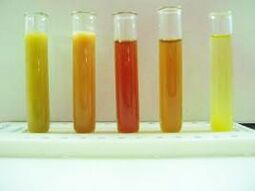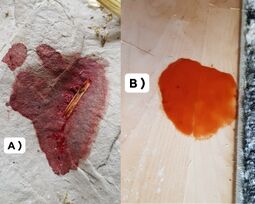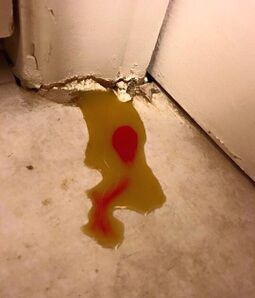Urine
Normal rabbit urine can vary considerably in visual appearance. The color can vary from a pale yellow common in other species to a range of oranges and brown to a deep red that is often mistaken for blood.
Association of Exotic Mammal Veterinarians writes:
Rabbits excrete calcium in their urine normally – that’s one reason why their urine can dry into a thick, whitish film. They also secrete normal porphyrin pigments into their urine that can make their urine appear reddish or rusty orange in color. Diet and certain medications can also sometimes change the color of rabbit urine. However, if you notice your rabbit urinating bright red blood, blood clots (which could be red, brown, or black), or straining to urinate, contact your exotic veterinarian immediately! This could be due to a urinary tract infection, bladder stones, urine sludge, or reproductive disease.[1]
Why does my rabbit's urine vary in color?
Rabbit urine can vary greatly in color from reasons such as diet (plant pigments, antibiotics, dehydration), stress, or blood.

Vegetables such as cabbage, broccoli, and dandelions often result in the excretion of red urine.[2] Foods high in beta-carotene, such as carrots and spinach, and ingestion of pine or fir needles can also cause reddish discoloration.[3] Note that the discoloration can be unpredictable, and that two rabbits on the same diet can have different colored urine. Generally the changes in urine color caused by diet last 2-3 days.[3]
Conditions that may cause bloody urine (haematuria) in rabbits include the following:[2][3]
- Kidney or bladder disorders such as infection, stones, cancer, or polyps
- Uterine disorders in unspayed females such as endometrial hyperplasia, infection, cancer, polyps, or abortion
To differentiate between blood and discoloration from dietary pigments, you can try the following:
- a Wood's lamp with ultraviolet light - urine will fluoresce, blood will not
- drips of hydrogen peroxide - blood will foam, urine will not
Generally, blood in urine will show up as streaks rather than a homogeneous color.

Why is my rabbit's urine cloudy?
Normal rabbit urine can be cloudy due to the presence of calcium carbonate precipitates. Intestinal absorption of calcium is related to the calcium content in the diet, and excess amounts are excreted by the kidney. The amount of precipitate in urine will consequently vary with the calcium content of the diet. Hydration status and pH of the urine can also affect the amount of precipitate.[2]:59
Rabbit urine can be clear during periods of high calcium demand such as growth, pregnancy, or lactation.[2]:59 A small amount of precipitate is a good sign as it reflects adequate calcium content in the diet, but excessive precipitation can form a thick sludge, which can result in bladder issues such as infection (cystitis, urethritis) and urinary incontinence.
Further reading
- Kinenchen. Guide to Bunny Pee (Graphic)
- Greendale Veterinary Diagnostics. Rabbit Urinalysis
- PetCoach. Red Urine in Rabbits: Causes, Diagnosis, and Treatment
- Natalie Antinoff. (2014). Urinary Disorders in Rabbits
- Ontario Rabbit Education Organization. Urinary
- Sandy Ackerman. Red Urine: Blood or Plant Pigment?
See also
References
- ↑ Association of Exotic Mammal Veterinarians (2018). In Facebook [Group page]. Retrieved 12 July, 2018, from https://www.facebook.com/AEMVeterinarians/photos/a.269819816396069/2228876670490364/
- ↑ 2.0 2.1 2.2 2.3 Varga, M. (2013). Textbook of rabbit medicine. (2nd ed.).
- ↑ 3.0 3.1 3.2 PetCoach. (n.d.). Red Urine in Rabbits: Causes, Diagnosis, and Treatment. Retrieved 14 May 2019 from https://www.petcoach.co/article/red-urine-in-rabbits/



